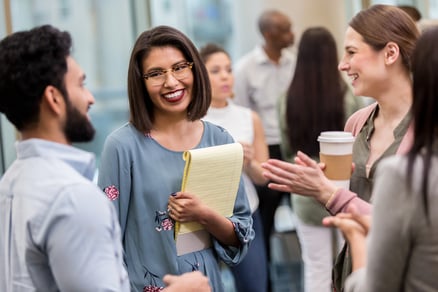What I Wish I Knew Before Teaching in a Full-Inclusion Classroom
One teacher who works with autistic students reports on the great benefits and challenges of full-inclusion classrooms for students with autism and other different abilities.
Education is continually evolving, bringing with it new concepts and buzzwords that can often leave the minds of educators spinning. Each year, educators are growing, adapting, learning new curricula, and taking on additional responsibilities. More recently, teachers are finding themselves jumping head-first into full inclusion.
Although the concept of full inclusion is not exactly new, the buzz surrounding full inclusion has recently ramped up, becoming the newest model adopted by many districts around the nation. In this article, I will share with you the biggest takeaways from my first experience co-teaching in a full-inclusion classroom.
What Is Full Inclusion?
Full inclusion is an educational model where all students (including students with Individualized Education Plans or “IEPs” ) are fully integrated into the general education classroom. The typical “pull-out” special education support that a student might receive from a special education teacher or related service provider is often replaced with services and support taking place within the classroom.
The concept of inclusion is not new. The IDEA law of 1973 allowed the inclusion of individuals with disabilities to attend institutions receiving federal funding. The law has undergone some updates and adjustments over the years. A reauthorization was made in 1990 stating that all schools were required to provide free, appropriate public education for all children. The public education received by the student is also required to be provided in the least restrictive environment.
Another reauthorization occurred in 2004 to more closely align with the No Child Left Behind Act of 2001. These adjustments, over the years, have paved the way for full inclusion which has drastically increased the percentage of students with disabilities that receive education in typical schools with more than half of these students being provided education and support within the general education classroom 80% or more of the school day.

My Introduction to Full Inclusion
My personal experience in a full-inclusion classroom felt like a bit of a whirlwind. My district at the time made a quick shift from what used to be a more “typical'' elementary school setting (general education classrooms and separate special education classrooms) to a fully inclusive model with a significantly reduced number of special education classrooms.
Over a short period of time, students with IEPs who were once in self-contained classrooms were projected to begin attending their home schools with placement in a general education classroom at the start of the following school year. With such a fast turnaround into full inclusion, each school in the district focused its efforts on specific classrooms to be the inclusion and co-teaching classrooms (with the intention of increasing the inclusion and co-teaching over the years to come).
The selected teaching pairs attended a few training/seminars on co-teaching and full inclusion by an expert in the field, which would later roll into coaching and mentoring from the expert. Even with the expert professional development before the school year started, we felt we needed more time to prepare. We began to overthink the situation by pointing out all the things that could go wrong.
Here is the truth: As educators, we are never fully ready to implement a new model or curriculum. We perfect our craft over time by learning from our mistakes, observing others, and reflecting on our teaching. You will make mistakes, but those mistakes will only seem like big mistakes to you. It is okay to make those mistakes and learn from them.
The most important thing to keep in mind is that you need to BE FLEXIBLE!
Getting Started
Once you know that you will be teaching in a full-inclusion classroom -- don’t panic! As a teacher, you are more equipped to take on this type of challenge than you think. You have a toolbox full of teaching strategies, classroom management skills, and the ability to support student social interactions. Below are some of the most important things to remember when you are getting started.
1. All students are general education students
Regardless of a student’s abilities or disabilities, every student is a general education student. IDEA and No Child Left Behind made sure that every student, regardless of need, has access to public education within the student’s hometown in the least restrictive environment possible. With that in mind, every student who walks through the school doors is a general education student before that student is a special education student. The IEP does not define who the student is but rather provides information on how to best support the learning and needs of the student.

When preparing your classroom for the start of the school year, prepare the way you always would. Name tags on desks, assigned cubbies, a classroom job list, homework bins, educational posters, etc. The only preparation that may be different is if a particular student requires a few extra items to be successful in the classroom. These items would be listed on the IEP accommodations page or brought to you by related service providers. Many of these tools are easy to incorporate into the school day and do not alter your way of teaching or running your classroom. A few examples are pencil grips, slant boards, movement cushions, preferential seating, an FM system for hearing impairments, the ability to stand while working, fidget- or sensory items available, ability to take breaks. You may find it beneficial to have a few extras of these items on hand. With all students being general education students, you will likely find that many of the students in your class benefit from pencil grips, movement cushions, sensory items, etc. A few students may even enjoy the opportunity to take a short break between subjects.
For students with autism, in particular, some additional strategies for setting up the classroom can be found in our article: Creating Spaces that Work for Children with Autism.
2. All students learn differently
All teachers, regardless of experience, know that all students learn differently. Each child is exactly that… individual! They all have different strengths, weaknesses, interests, learning styles, and communication skills. Differentiating instruction is second nature to educators. Therefore, when you are informed that you will be teaching a full-inclusion classroom with students who have IEPs and some bigger challenges than most…do not freeze in fear! You already have these tools in your toolbox.
It is important to focus on the strengths of all the students and use them as access points to their learning. All children show their understanding in different ways, so be flexible. Modifications to assignments and tasks do not need to be hard. Instead of requiring a written response to a question try switching it to a verbal response or multiple-choice question. If a student struggles to set up a multi-digit subtraction problem by not lining up the numbers correctly, do that part for the student so the student can focus on the ability to subtract rather than line up numbers. Simple changes like these do not change the curriculum but provide access points and a student's ability to show growth and understanding. Take a little time to reflect on your teaching. Make some notes about what worked and what didn’t. Learn from those difficult moments and continue to grow as an educator as you learn more about the needs of the students.
3. You are not alone
Teaching in a full-inclusion classroom is not a one-person job! You are not expected to do this on your own. Inclusion classrooms can be set up in a variety of ways. However, most commonly, a resource teacher will be assigned as the co-teacher to the classroom. The co-teacher will be with you all day as a second teacher and an expert on the needs of the students. In other cases, the resource teacher is a co-teacher but may not be in the room all day. Instead, the co-teacher may come in for a longer period during core subject areas to assist and co-teach.
 Additionally, many students with IEPs have additional support provided by related service providers. In this case, you will likely find the related service providers (speech, social work, OT, PT) will come into the classroom to support students rather than “pull out.” In a full-inclusion classroom, this is your team! Collaborate and work together to adjust lessons, problem-solve behaviors, and work together to incorporate new strategies. As much as you need them, they need you. Be sure to communicate often about schedule changes, class rules, seating changes, etc. Doing this will allow for things to run smoothly in your classroom and make each team member feel like an equal.
Additionally, many students with IEPs have additional support provided by related service providers. In this case, you will likely find the related service providers (speech, social work, OT, PT) will come into the classroom to support students rather than “pull out.” In a full-inclusion classroom, this is your team! Collaborate and work together to adjust lessons, problem-solve behaviors, and work together to incorporate new strategies. As much as you need them, they need you. Be sure to communicate often about schedule changes, class rules, seating changes, etc. Doing this will allow for things to run smoothly in your classroom and make each team member feel like an equal.
With the rise in full-inclusion classrooms, we are seeing more curriculums focused on one-to-one learning that co-teachers or general education teachers can use with minimal training. These curricula, such as the ARIS® Academic Readiness Intervention System complete autism curriculum, contain everything needed in one place to provide research-based instruction to children with autism or other language or emotional behavior challenges.
As the buzz for full inclusion continues to increase, your fear of jumping in headfirst should not. Teachers are remarkable individuals who acquire more skills, strengths, and abilities each school year. The skills and strategies you need to be successful in a full-inclusion classroom are likely skills you already have. All it takes is a little extra awareness of those skills and how they are used, teamwork and collaboration, and the willingness to reflect and grow each day.
If you follow these suggestions, you will end your school year the way I did when I jumped into full inclusion: Successful, accomplished, and transformed. Your students will leave for summer break knowing more about who they are as a learner, possess the ability to see past differences in each other, and with an overwhelming sense of belonging and success.
As a parent or teacher, have you had a positive or negative experience with full-inclusion classrooms? We would love to hear about it. Let us know in the Comments section below!

Lauren Ciran
Lauren has been a special education teacher for eleven years for both private and public schools. She began as a self-contained classroom teacher for students with severe and profound needs but has spent the majority of her career as a case manager and resource teacher for special education students in general education classrooms. Most recently, she took part in a major switch to full inclusion and co-teaching. Although it was challenging, she very quickly saw the benefit it had on all of the students. After recently making a major move from Illinois to Florida, she has started to shift her career out of the classroom while still supporting students, families, and schools by sharing my experiences, knowledge, and expertise as it relates to special education, inclusion, co-teaching, and the IEP process.




